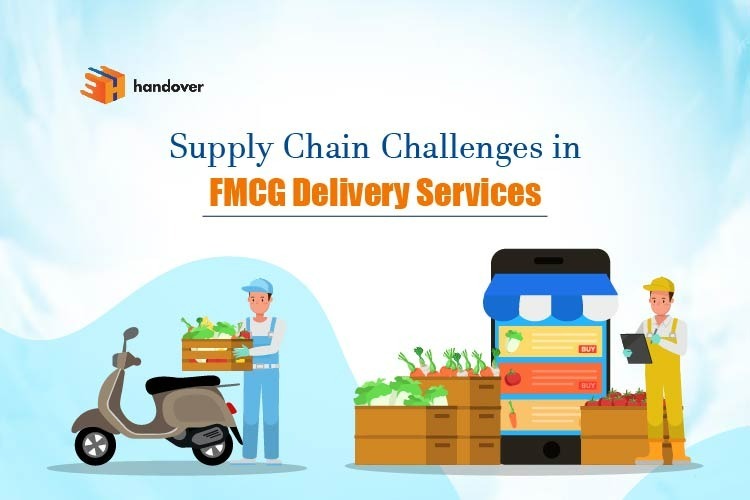Handover news
Blog
Supply Chain Challenges in FMCG Delivery Services

In business, we need a steady stream of everyday items like food, drinks, and cleaning stuff to sell. These are called Fast-Moving Consumer Goods (FMCG). To get these things to stores quickly and cheaply, businesses rely on a special system called a “supply chain.” But if this chain gets messed up, it can cause big problems. In this blog, we’ll explore the Indian FMCG market, understanding its unique characteristics, challenges, and opportunities. Identifying the same will help address challenges related to FMCG delivery services in Ghaziabad, Delhi, Noida, Mumbai, Pune, Bangalore and other cities across India.
Breaking Down Supply Chain Challenges
Guessing What Customers Want
Sometimes it’s hard for stores to know how much of things like snacks and toiletries to keep in stock. People buy these things quickly, and sometimes they want more than usual, sometimes less. It’s tricky because what people buy changes depending on the time of the year, what they like, and what’s popular. If the store gets it wrong, it might run out of stuff or have too much left over. This messes up when things get delivered and how much money the store makes.
Getting Things Where They Need to Go
Making sure stuff gets to the shops and customers on time is really important. But sometimes, the roads are jammed, or there aren’t enough good roads, or it’s hard to get the last bit of the delivery done. Fixing these problems and making sure things are delivered smoothly can help the whole system work better.
Seeing What’s Happening in the Chain
Not knowing what’s happening with the stuff being sold makes it hard for everyone to plan. Without knowing how much stuff is left, where orders are or when things are going to arrive, it’s tough to handle when people want different things or if there’s a problem. Using technology to keep track of everything can make things easier for everyone.
Making Sure Things are Good Enough and Legal
Making sure the stuff being sold is of good quality and follows the rules is really important in this business. But it’s hard to do that when there are lots of different suppliers, factories, and ways things get to the shops. If things aren’t good enough, it can mean having to take products back, which can hurt the FMCG store’s reputation and make it lose money.
Dealing with Busy Times and Special Offers
Sometimes, more people want to buy things because of holidays or special deals. Managing how much stuff is made and sent out during these times without having too much leftover is a big challenge. FMCG businesses have to guess what people will want and make sure there’s enough but not too much.
Keeping Costs Down
Running this kind of business costs a lot, and there’s not always a lot of money left over. Things like paying workers and other expenses can eat into profits. Finding ways to spend less without hurting the quality of service is tough but important for the business to keep going.
Addressing Challenges
1. Use Technology
FMCG businesses can use fancy technology like special systems to keep track of inventory, software to manage transportation, and smart tools to predict what’s going to happen next.
2. Work with Others
Building good relationships with suppliers, makers, delivery people, and others in the supply chain helps everything run smoothly. Sharing info and working together makes things easier.
3. Make Deliveries Better
By planning the best routes, automating tasks in warehouses, and only getting stock when it’s needed, they can make deliveries faster, cheaper and better.
4. Check Quality
Making sure products are of good quality and meet the rules all along the supply chain is important. They can do this by checking regularly and getting official stamps of approval.
5. Be Eco-Friendly
Being kind to the environment by using eco-friendly packaging, choosing green ways to move stuff around, and getting materials from good sources shows a caring approach from businesses. It also attracts people who want to shop with companies that do good things.
6. Go Online
Selling stuff online and using the internet to reach more customers helps them grow. They can also give customers better ways to shop.
7. Keep an Eye on What’s Popular
Knowing what people like to buy, what they don’t like, and what other companies are doing helps them plan and change it when they need to.
Conclusion
Dealing with problems in getting FMCG goods delivered needs careful thinking ahead, working together, and coming up with new ideas. If companies tackle issues like guessing how much stuff people will buy, making delivery plans better, knowing where everything is in the supply chain and being eco-friendly, they can make things run smoother, reduce risks, and make customers happier. By using new tech, working well with others, and focusing on what customers want, companies can beat the tough competition in the FMCG world. FMCG businesses can always rely on the logistics prowess of handover (handover Karo, Khush Raho), a leading logistics company with an extended delivery fleet comprising 2-wheelers, 3-wheelers, trucks, electric vehicles, etc. Collaborate now for an extended reach.
